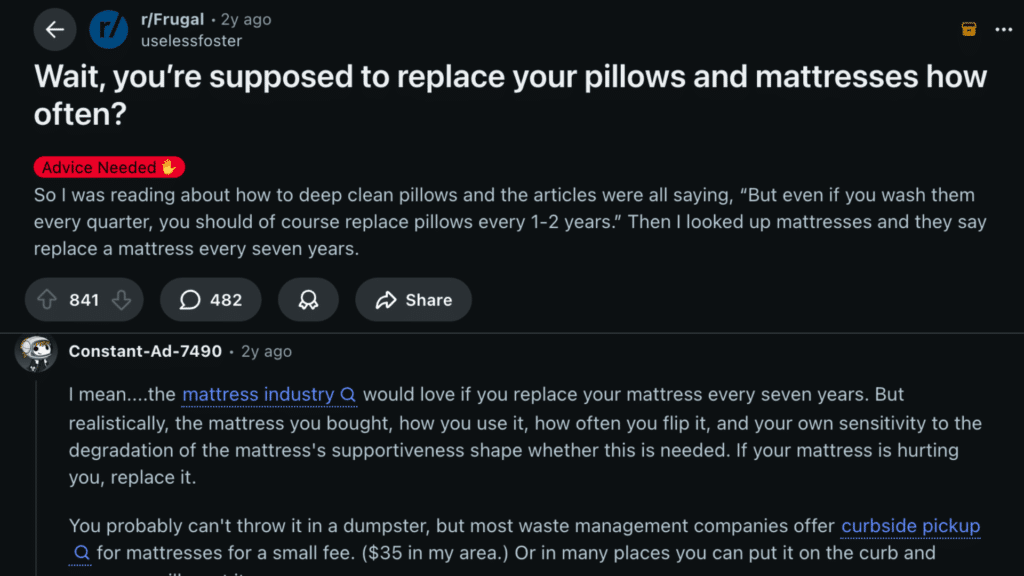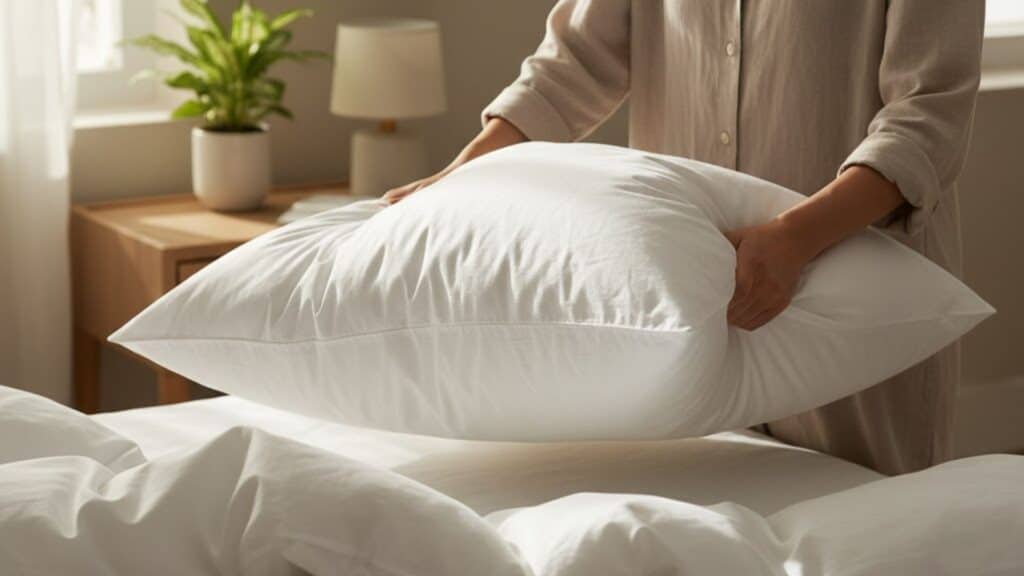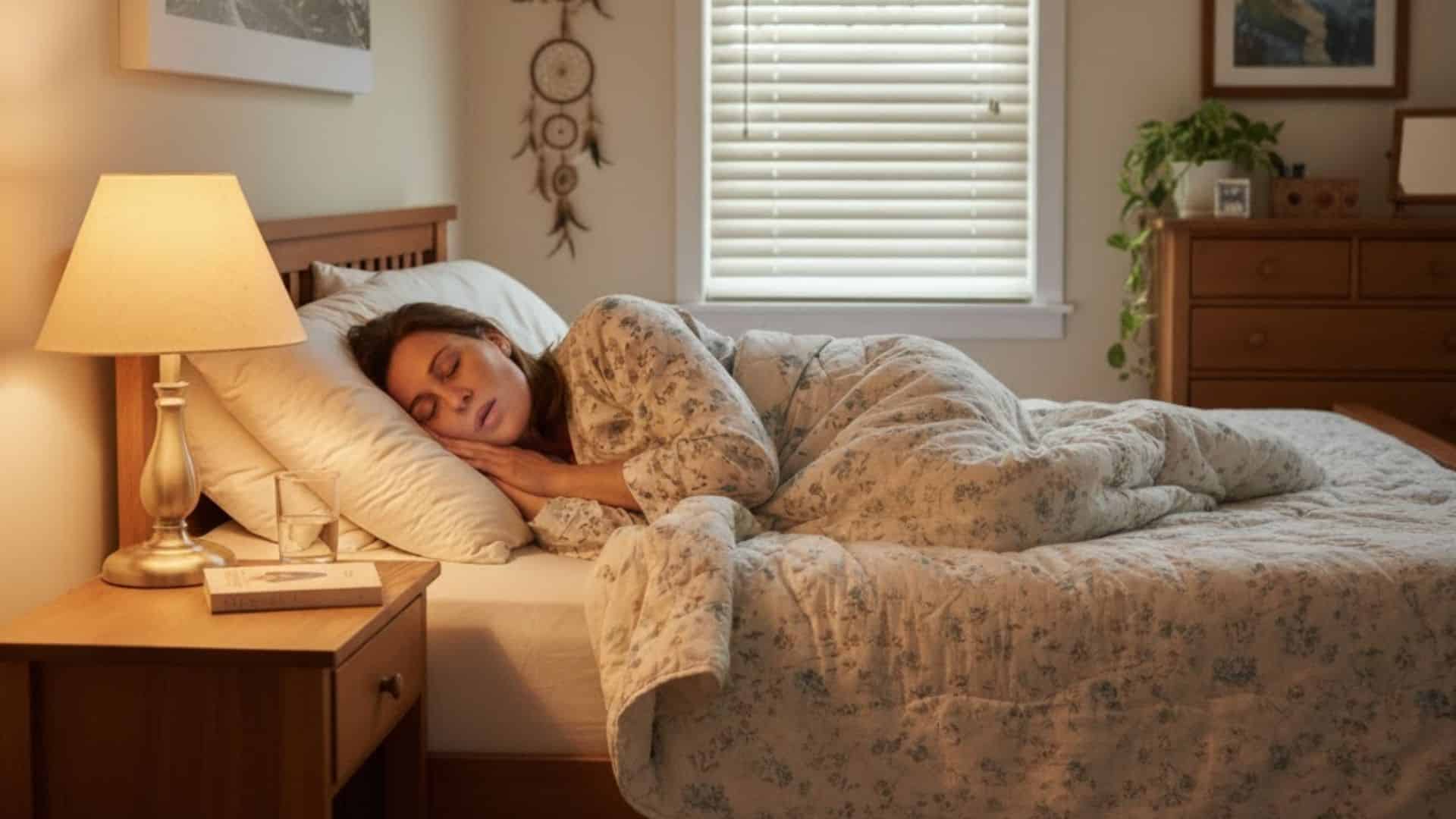I’ll be honest: I never used to think about replacing my pillows. They seemed fine, even as they got flat and a little sad-looking.
But over time, I realized that old pillows can mess with your sleep, your neck, and even your skin.
If you’ve ever wondered how often should you replace pillows, this guide is for you. We’ll talk about what really happens inside an old pillow, how long different types last, and the signs it’s time for a new one.
You’ll also find simple care tips and ways to recycle the old ones responsibly. By the end, you’ll know exactly when and why to make the switch.
Why Replacing Your Pillow is Important
Your pillow might look fine on the surface, but what’s inside tells a different story. Over time, it stops offering proper support and starts collecting things you’d rather not sleep on.
1. Support Fades Over Time
Every pillow breaks down with use. The filling compresses, loses loft, and stops holding your head in proper alignment. When that happens, your neck and spine no longer stay supported, which can lead to:
- Morning stiffness or headaches
- Tossing and turning during sleep
- Uneven pressure on the shoulders and upper back
A worn-out pillow might still look fine, but it quietly stops doing its job.
2. Hygiene Becomes a Problem
Your pillow collects more than you realize: sweat, skin oils, and hair products slowly soak through pillowcases. Inside, that moisture becomes a perfect home for dust mites and bacteria.
Even regular washing can’t reach what’s deep in the filling.
This buildup can cause:
- Stuffy nose or sneezing at night
- Itchy eyes or skin irritation
- Breakouts from contact with dirty fabric
3. Hidden Health Effects
Old pillows don’t just feel uncomfortable; they can affect how you breathe and how your skin reacts.
People with asthma or allergies may notice more flare-ups because of trapped dust and microbes.
Dermatologists also note that pillow residue can clog pores and undo your nightly skincare efforts.
4. Why a Fresh Pillow Matters
Replacing your pillow on schedule helps you:
- Maintain posture and spinal alignment
- Reduce allergens where you sleep
- Sleep more comfortably without stiffness or irritation
A clean, supportive pillow might seem like a small upgrade, but it makes a big difference in your overall rest and well-being.
How Often Should You Replace Pillows?

Most pillows need replacing every one to two years. Over time, the filling flattens and stops supporting your head and neck properly. When that happens, you may notice stiffness, soreness, or restless sleep.
The type of pillow makes a big difference.
- Synthetic or polyester fill: usually lasts up to a year.
- Down or feather: can stay comfortable for two to three years.
- Latex or memory foam: often lasts up to four years with good care.
Care and use also affect how long your pillow holds up. Regular washing, using a pillow protector, and letting it air out in sunlight can help extend its life.
Even with perfect care, every pillow wears down eventually. If it feels flat, smells odd, or leaves you with neck pain, that’s a clear sign it’s time for a replacement.
So when you ask yourself how often you should change pillows, let comfort and condition guide your answer.
Average Pillow Lifespan by Material
The exact answer to how often you should change pillows depends on what they’re made from. Here’s a general breakdown by material:
| Pillow Type | Average Lifespan | Notes |
|---|---|---|
| Polyester / Fiberfill | 6 months – 2 years | Flattens quickly; affordable but least durable. |
| Down / Feather | 1 – 3 years | Lasts longer with regular fluffing and airing. |
| Memory Foam | 2 – 3 years | Retains structure better but may trap heat. |
| Latex | 3 – 4 years | Naturally resilient; resists dust mites. |
| Buckwheat | 3+ years | Replace hulls as they compress over time. |
The lifespan of a pillow depends on its materials, how often it’s used, and how well it’s cared for. Even high-end options lose firmness with regular use.
Signs It’s Time to Replace Your Pillow

You don’t need a reminder app or calendar to know when it’s time for a new pillow; the signs are usually right in front of you.
Watch for these clues:
- It’s lost its shape or fails the fold test (it stays folded instead of bouncing back).
- The surface feels lumpy, flat, or uneven even after fluffing.
- There’s a noticeable odor or yellow stains that don’t wash out.
- You wake up sneezing, congested, or with neck pain that fades during the day.
A quick monthly check makes all the difference. Squeeze it, fold it, and take a quick sniff. If it doesn’t spring back or feels lifeless, your pillow has reached the end of its run.
Hygiene Insights: What’s Inside an Old Pillow
Your pillow can hold more than just comfort. Over time, it absorbs sweat, oils, saliva, and dead skin cells, which stay trapped inside the filling.
That trapped moisture and warmth create the perfect environment for dust mites, bacteria, and microscopic fungi to grow. Even frequent washing can’t remove what builds up deep inside.
You might experience:
- This buildup may cause breakouts and clogged pores
- It can trigger sneezing, congestion, or breathing trouble
- People with asthma or allergies may notice more nighttime irritation
Replacing your pillow regularly helps keep your sleep space cleaner, improves air quality, and supports healthier skin and breathing.
How Often Should You Change Pillows: Real Insights

On Reddit, many people admit they’ve kept the same pillow for three to five years or more, far beyond what experts recommend.
Most say they never thought about replacing it because it still felt comfortable, while others simply forgot that pillows wear out faster than mattresses. A few only realized the issue when they started waking up with stiff necks or allergy symptoms. A
discussion thread titled “Wait, you’re supposed to replace your pillows ?” captures that habit vividly. It’s clear that comfort often wins over support, but a pillow that feels familiar isn’t always doing its job.
From my view, it’s better to check your pillow’s condition every few months instead of waiting until it feels unusable.
Give it a quick squeeze or fold test, and if it’s flat, smelly, or lumpy, mark a reminder to replace it within the next year or two. Small habits like that keep your sleep space cleaner and more supportive in the long run.
Pillow Replacement for Different Sleeper Types
Your sleeping position affects how quickly your pillow wears down. Some types flatten faster, while others hold their shape longer, depending on how much pressure they handle each night.
| Sleeper Type | Ideal Pillow Type | Why It Works | Average Lifespan |
|---|---|---|---|
| Side Sleepers | Firm, high-loft pillow | Keeps the head and neck aligned with the spine; supports the shoulder gap | 1–2 years |
| Back Sleepers | Medium-loft pillow with balanced support | Maintains the natural curve of the neck and prevents tilting forward | 2–3 years |
| Stomach Sleepers | Soft, low-loft pillow | Reduces strain on the neck and lower back by minimizing height | 1–2 years |
| Combination Sleepers | Adjustable or shredded-fill pillow | Adapts to multiple positions throughout the night | 2–3 years |
Matching your pillow’s firmness and loft to your sleeping style keeps your posture supported and helps prevent early wear. It also improves comfort and reduces morning stiffness.
Care Tips to Make Pillows Last Longer
No pillow lasts forever, but a few small habits can help you get the most out of yours. These steps keep your pillows fresher, cleaner, and more supportive over time.
- Use pillow protectors: Place them under your regular cases to block moisture, sweat, and dust.
- Wash pillowcases weekly: This prevents buildup from skin oils, sweat, and hair products.
- Wash the pillow every few months: Follow the care label; most synthetic and down pillows can handle gentle washing.
- Spot clean and air out: Memory foam or latex pillows should never be submerged; instead, spot clean and let them breathe.
- Air pillows in sunlight: Sunlight naturally helps remove odors and moisture.
- Rotate pillows regularly: Switching them every few months helps even out wear and keep their shape.
Good care habits won’t make your pillow last forever, but they’ll slow down flattening and help maintain a cleaner, more comfortable sleep setup.
Eco-Friendly Disposal & Recycling Options
If you’re ready to replace your pillows, don’t toss the old ones just yet. There are smarter ways to handle them that keep useful materials out of landfills and give them a new purpose.
- Repurpose: Turn old pillows into pet beds, floor cushions, or packing filler for fragile items. You can even reuse the stuffing for small crafts or draft stoppers.
- Donate: Clean pillows in good condition may be accepted by animal shelters or community groups. Always call ahead to check donation rules.
- Recycle: Many cities now have textile recycling programs, and some home-goods stores collect used bedding. Sites like Earth911 can help you find drop-off centers nearby.
- Compost: Natural fillings such as buckwheat, feathers, or latex can often be composted safely. Cut the cotton cover into strips to help it break down faster.
- Choose Better Next Time: When buying new pillows, consider options made with organic, recycled, or plant-based materials. Some brands even offer take-back or recycling programs.
These small steps not only reduce waste but also make your pillow upgrade feel more thoughtful and environmentally friendly.
Wrapping Up
Now that you know how often you should replace pillows, it’s easier to keep your bed fresh and your sleep healthier. A clean, supportive pillow can make a real difference in how your body feels each morning.
I hope this guide helps you notice the little signs that your pillow’s time is up, and gives you simple ways to make each one last longer. Taking care of the things you sleep on doesn’t have to be complicated; it just takes a little awareness and routine.
If you found this helpful, take a look at some of my other posts for more everyday tips on comfort, care, and better sleep.









